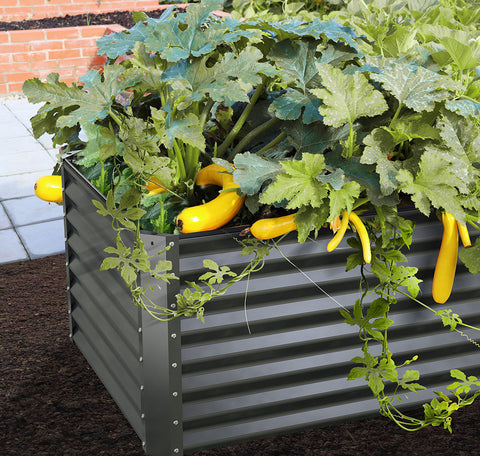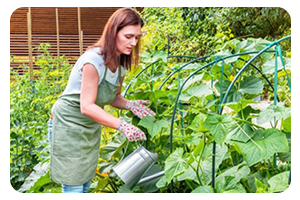Being a new gardener is hard. There are many things to learn when tending a vegetable garden - how to plant seeds, how to care for your plants, how to prevent diseases... The following content also has some reference value for raised garden beds.
But would you believe me if I told you that one of the most common mistakes new gardeners make is one of the easiest to correct?
This article will give you an overview of when to water the garden, but more importantly explain why. Once you understand why, you'll never forget when to water again.
Ps: Before watering, make sure you have a quality garden hose, hose nozzle, and hose reel! We carry Dramm Premium Garden Hose, Dramm Touch 'N Stream Revolver Airbrush, Dramm 30 "Select Rain Stick, and Yard Butler Hand crank reel in our store. These are high quality products that are sure to help you water effectively.

The best time to water: As Early as Possible in the Morning
If you're a morning person - unlike me - you'll be pleased to learn that early morning is undoubtedly the best time to water your plants (or any garden, for that matter).
The reason is simple: When you water in the morning, the sun has just risen and the temperature is still low. The water has time to soak into the soil and into the roots of your garden without evaporating.
Early watering also protects your plants from midday heat (the worst time to water plants) because they will already be filled with water when the day's heat really hits them. It's much better than trying to "save" your plants by watering them in the afternoon on a hot day.
Debunking gardening myths: Some old gardeners insisted that watering during the day would leave your plants "scorched" by the sun. They claim that when the sun comes out, water droplets on the leaves of plants have an amplifying effect and can burn the leaves.
While this is physically possible, it is extremely unlikely because most climates are not hot enough to cause this effect. If they do, your plants may have other, more serious problems.
This is even more beneficial if you use a drip irrigation system or soaking hose to water.
Second best time to water your garden: Late afternoon or Early evening
If you're not a morning person like me, water your plants in the late afternoon or early evening. The rule here is clear: You want to do everything you can to avoid watering in the middle of the day.
While watering at the end of the day is worse than watering early in the morning, it's certainly better than not watering at all if you have no other options!
If you choose to water the plant at night, try not to saturate the plant's leaves with water. Moist leaves are at the root of many pathogens and diseases, such as the dreaded powdery mildew, which can destroy entire gardens. At best, you'll lose excess water.

Don't water at night
Don't water at night if you can avoid it, and don't water at night. The biggest reason is what I mentioned above - you wet the leaves and plants at night, when there is little evaporation. You don't give the soil time to dry. This is a recipe for disease and decay, not a recipe for a healthy garden.
If you can't wait, drink water at night. But use less water than usual because it doesn't evaporate. This means that all the water you pour on the soil will sink and be consumed by your plants.
Tips for watering your garden
Now that you know the best time to water your garden, let's take a look at some other mistakes gardeners make when watering:
Overwatering the garden should be avoided at all costs.
Overwatering is one of the biggest mistakes gardeners can make. This is very easy to do, and too much water can have disastrous consequences. Watering too often can kill vegetable plants and potted plants just as easily as watering too little. If you're having a hard time recognizing the signs of excessive drinking, check out:
- Wilted plants look soft or "damp"
- Decaying at the root or stem level
- The tip of a leaf that is turning yellow
The water never stops.
As a rule of thumb, it's a good idea to give your garden and container plants about an inch of water a week. But it's like any rule -- it's meant to be broken. Some plants need a lot of water, while others need almost nothing. You should study the plants in your garden to find out how much they need.
You may need to water some parts of the garden and container plants 2-3 times a week, and other parts only once a week if needed. To tell if your garden needs watering, you can test with your finger:
Finger test: Put your finger in 2 "deep soil. If there is no moisture at all and you find the soil dry, you need to water your garden. If the water is about 1 "deep, you may not need to water.
And use your head! If you've just been through a storm, you probably won't need watering for at least a week. A rain gauge can help you determine how much rain you need to replenish. If it hasn't rained in months and the temperature is high, give your garden some more liquid water!
In short, regular watering is the most important rule.
Try to water the surface of the soil, not over the leaves.
When you water your garden, you are trying to get the water to the root system. Don't pour it randomly over the leaves. This is just wasted water that will evaporate from your plants. You can water at the best time for irrigation, but doing so will cost you valuable water.
Instead, water the root zone. This promotes root growth and watering as effectively as possible. Combine that with using your morning hours to water your plants, and your garden will be properly watered.
When watering, water deeply.
Instead of watering several times a week in the morning, consider watering deeply once a week. This means staying in one place until you are sure the water has penetrated deep into the soil. The deeper the water is buried, the less likely it is to evaporate from the soil, and the more it encourages the plant's roots to extend deeper and form healthy roots.
A plant with deep roots usually means the plant grows better, so even using watering sticks for long periods of time will be better!

Ways to water a garden
Now that we've covered the best time to water your plants, let's discuss some ways to water your plants.
Soaker hose and drip irrigation
Experienced gardeners often use soaking hoses in their vegetable gardens because of their ability to continuously and deeply water. Throw away the garden hose! All you have to do is put them at the bottom of the plant and turn them on when you want to water them.
Similarly, drip irrigation is a slow watering method that gives the gardener the option of irrigating above the surface of the soil through an overhead sprinkler or slowly releasing water onto the garden bed through a drip belt.
A great feature of these two watering methods is that they can be set to a timer, allowing you to schedule the watering time of your choice. On hot summer days, this is a great asset to have in your gardening kit. Personally, after I switched to timed drip irrigation, my summer crops began to bloom!
Another benefit of using timers is that they can help you conserve water during periods of drought. This helps you comply with local regulations regarding water conservation.
Passive irrigation
There are plenty of passive irrigation methods that are sure to help you water your garden and stay within municipal water regulations. We don't have time to discuss them all here, but let's discuss some!
Of course, we are biased when it comes to Lola. The drip Roller The small roller watering pot is a time-tested method of passively watering your garden through clay pot irrigation. You bury chrysanthemums in the garden and fill them with water. Over time, the pores in the clay pot slowly release water for the plant to absorb in its roots.
Other passive systems, such as bottomland and rain gardening, allow your garden to absorb water from the side while giving your landscaping some dimension. Both methods involve digging shallow trenches near growing areas to allow rainwater to flow in. As water collects in these areas, the plants absorb it from both sides.
Another passive method of fetching water is to collect it through rain barrels. You can install an overflow tube on the side of the bucket, which will divert water into the garden when the bucket can't hold it. This can help you save water and enjoy the garden a little more, instead of consuming energy, to make sure everyone has what they need.









